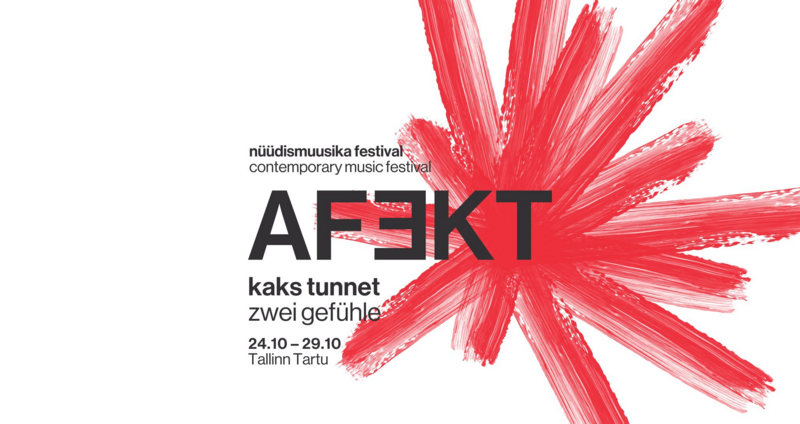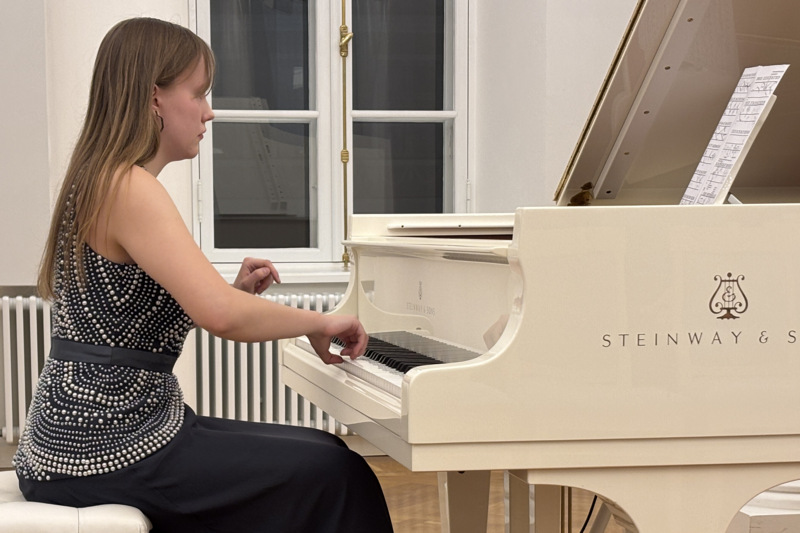Though it has the semblance of being international, AFEKT is for the most part a German-oriented festival, in terms of both composers and performers. As usual, members of Ensemble Musikfabrik were in attendance – Marco Blaauw (trumpet), Christine Chapman (horn), Lucy Humphris (trumpet), Stephen Menotti (trombone) and Maxime Morel (tuba) – taking the helm at a concert in the Estonian Academy of Music & Theatre (EMTA). They performed four works, some of which seemed to take their starting point from Helmut Lachenmann’s radical rethinking of music and timbre, heard elsewhere during the festival.

One of them, Krõõt-Kärt Kaev‘s Undulation for solo trombone, was a complete failure. The addition of water into Menotti’s trombone was promising, but the result could hardly have been more dismal. An extremely limited range of sounds barely emerged, none of them unexpected, and hardly ‘controlled’ in a meaningful sense. Comprising assorted gurgles and some barely pitch-shifting air, it was a total waste of time, effort, and a commission fee. (A second work of Kaev’s, CH for solo horn, was quietly dropped from the programme; perhaps we got lucky.) Much better was Slēptā gaisma [hidden light] for brass quartet by Latvian Jānis Petraškevičs. It was fascinating the way the music slipped between being individuated and coming together, though always sounding unified. This was achieved in part through textures displaying behavioural similarities, networks of deep pedal notes – which were particularly wonderful – and fanfaric passages. In its eschewing of avant-garde, extended technique tropes clichés, it maintained a beautiful sense of focus.
The longest work on the programme was Heart Blowing by Georges Aperghis, which felt akin to a stage play reconfigured for brass quintet. It was impossible not to imagine a narrative (even a script) lurking behind its wild theatrics. Some of the most memorable sequences were its biggest: the first outbreak of ferocity, just moments after a tight rhythmic unison introduction; the playfulness that followed, becoming full-blown, overblown flamboyance, like a group of drunks all singing over each other, possibly the same song but who could tell? There were also telling quieter moments, particularly a recurring idea of soft, muted group tremolandi. Yet the work’s anonymous, seemingly arbitrary pitch content, in conjunction with its wildly rhapsodic demeanour, conspired to highlight what felt increasingly to be musical limitations. Was there anything below its crazed surface? Half an hour of superficial fun and fireworks?

Most memorable was and still it breathes… by Irish composer Ailís Ní Ríain, receiving its world première. The opening was highly arresting: a gentle collection of pitches, jarring against and complementing each other, abruptly defocused into broken and fragmented articulations, in every sense aspirational. Purrs, growls, flutters, tremors, all these sounds accentuated their mouth-initiated point of origin, in the process sounding incredibly tactile. A fascinating chorus emerged, where played and sung notes melded together. Despite the nature of the soundworld, it never tipped over into something wild, remaining focused on the instruments themselves and their means of sound production. Can music be abstract and wistful simultaneously? What ensued tapped into this duality, at once cool and warm. Rhythmic staccatos, tight and constricted, were followed by their opposite, a kind of low-key flamboyance, frilly, flurried notes leading into a strange, secondary paradox, sustained and wavering yet also breathless, finally subsiding into infinitesimal squeals and snuffles.
More of Arvo Pärt‘s early music was heard on the final day of the festival, in a recital given by pianist Tähe-Lee Liiv, in the University of Tartu’s grand Assembly Hall. Two years ago, Liiv released an album of Pärt’s complete piano music, the first half of which comprised the first half of the concert. On the recording, Liiv demonstrates fantastic intricacy (she must sound marvellous performing Baroque music), and despite the slight resonance of the Assembly Hall, that was what typified her performance here too. She made the playful, neoclassical tumbling of Sonatina No. 1 ultra-clear, in the process qualifying its tone of fun with an underlying seriousness. This was extended in its second movement, measured but allowing passion to speak before regaining composure. Likewise the Partita, an exercise in consummate contrapuntal clarity despite ramping up the momentum, using the Larghetto movement to balance the lively Fughetta, and also Sonatina No. 2, moving between strong drive and slow reflection, filled with understated intensity.
The Dances from Music for Children’s Plays came and went as the incidental light music they are (though Liiv prevented them from ever sounding trivial), but most fascinating of these early works was Diagrams, an aleatoric work from 1964. Liiv made its opening minute or so exhilarating, giving lyricism to angular, cross-registral shapes, only to have them explode moments later, letting the resonance flood the space for a long time while we recovered from the blast. Finally, thoughtful pitches sustained in space felt akin to the firing neurons in our brains trying to figure out the (dis)continuity of this stimulating curiosity.

The latter half of the concert moved into more international but tangentially-connected territory. Magnus Lindberg‘s Etude No. 1 was made to feel as if it had conflicting forces brought to bear on it, not only pulled along but also up and down simultaneously. The result was a highly florid kind of momentum-less forward motion that seemed hard to fathom. Even more baffling was Lachenmann‘s Guero, a piece Liiv didn’t seem to really believe in but nonetheless managed to make occasionally tantalising when tiny hints of pitch materialised from its collection of frictional gestures. Einojuhani Rautavaara‘s set of Etudes had their moments but one couldn’t help feeling they were essentially the same piece again and again, slightly varied.
Most engaging of all was the Toccata by Jörg Widmann, composed in 2002. Despite its name, it initially had a chordal focus, with note threads being pulled and prolonged from them. Again the polarisation – Liiv realises such material extremely well – cautious yet volatile, with traces of line becoming apparent before turning tremulous, as if something clear were being shuddered and violently vibrated into a rich blur. Separating out into a mixture of fast repetitions (middle) and staccato accents (high / low), the whole thing careered at speed into a huge slam of the piano lid, Liiv dauntlessly continuing to ‘play’ on its surface.
Though she hasn’t released anything other than the Pärt disc, both the Rautavaara Etudes and Widmann Toccata can be found on Liiv’s YouTube channel.
Something i always aim to experience at music festivals – when they’re included – are concerts featuring student composers and performers. There’s an obvious tendency for them to be naive, stylistically derivative and qualitatively erratic, but there have also been numerous occasions when i’ve been genuinely wowed. That’s exactly what happened during this year’s AFEKT, at a late evening concert in the Estonian Academy’s cube-like Black Box space. There were three performances, two of which were typically humdrum. Roya Naini and Giustino Kabiro didn’t so much perform together as adjacently, Naini stroking a custom instrument apparently made of glass tubes, while Kabiro indulged in the usual stream of electronic consciousness. There was little to indicate how the two parts were interacting, nor any sense of anything meaningful beyond the ever-changing surface details. Canetamburo, a trio comprising Elia Dell’Orco, Eugenio Cecchini, and Gabriele Teti, gave what was initially a more polished and considered performance, but the longer it went on the greater the toll it seemed to take on their combined imagination. The large number of novelty objects strewn across their respective tables ended up being utilised to create a soundworld that descended into disposable silliness.
The highlight came from another trio, accordionists Darja Goldberg and David-Ovid Komlev with Marina Karpova on modular synths, under the name Electro Funeral. They positioned themselves on the balcony of the Black Box – Komlev at one end, Goldberg at the other, with Karpova in the centre – and they were nothing short of magnificent. Their performance was hugely immersive from the outset. Strange, strained clusters and key clicks were joined by a deep pulse. The clusters prevailed, only to be replaced by soft, high tones and whistles, mysterious and distant. Crackling from somewhere, fast rising electronic tones like a kind of incense, and a voice (Goldberg’s) could be heard, before everything expanded into a dense, juddering wall with the accordions protruding out from it, while the pulse beat irregularly within.

These opening few minutes promised a lot, and they were entirely lived up to in the rest of the trio’s nearly 25-minute performance. Density continually evolved, and with it elements materialised and were reabsorbed. Squelches swelled over floating clusters, becoming a vibrating, flexing entity, large and looming. It was like a pure ball of energy; the clusters shimmered, both on its surface and within its core, electrified ripples ran across, as if we were zooming in on parts of its detail. Ghostly echoes of something playful, jaunty but half lost in reverberance; strange chords caught in an almost stasis; glimpses of uncanny wavering notes and a low buzzy presence. That wavering semi-solidified into something chant-like, while the chords became a drone, producing an atmosphere of ritual charged by an underlying rapidity in the synths, seemingly set to burst.
By now, the accordions seemed like disciples either side of a central priestess, Goldberg’s voice veering between unidentifable and words suggesting something ominous and terrible toward the end. It was as disquieting as it was arresting, culminating in a return to the softer elements from earlier, incense tones, ripples, soft percussive tappings and ebbing clusters. Dissolving and crossfading into birdsong was a delicious closing gesture, suggesting a final withdrawing from the mysterious power of an all-enveloping inner sanctum, out into a world where birds improbably sang in total darkness. Breathtaking.
The trio has made their AFEKT performance available from the Nina website, where it goes by the name Requiem, and the notes clarify that the words are by Mohamed Moussa, and the dark, ominous quality to the music is due to it being a response, and tribute, to the victims of Gaza. Also available on Nina is a live performance from earlier this year which is somewhat more energetic, but gives another strong indication of how impressive these three are when they get going.

